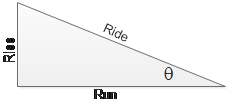Gravity and Hills
We have already seen gravity playing a role in rolling resistance through the CyclistCycle weight. Here we to extend the discussion of gravity to hills which interestingly enough is also related to the CyclistCycle weight.
Gradients vs. Slopes
Slopes are characterize in two ways and it is important to keep them straight. An ascent can be define by the Slope Angle θ of the climb. Engineers use another measure called grade. Grade is computed as Rise/Run. For a rise of 100 ft and a run of 100 ft, the grade is 10%. Grade and slope angle have different numerical values.
The relationship between the two can be computed as follows:
Gradient = (Rise/Run) * 100 = Tan θ * 100
Θ = Tan-1 (Gradient/100)
Gravitational Force on Cyclists
On hills, gravitational forces or more like rolling resistance in that they are constant during the ascent. On the flats, all of the CyclistCycle weight is directed into the road surface. But on a hill, the effect of the slope is to shift a portion of the weight in a downward direction along the slope and a reduced portion into the road.
How the CyclistCyle weight is distributed is computed using simple Trigonometry using the slope angle. The portion of the weight directed into the road surface is given by mgCosΘ while the portion along the slope is mgSinΘ.

For small angles, SinΘ approximately 0 and CosΘ approximately 1. On small grades, this tells us the portion of the Weight into the road is nearly equal to what it would be on the flats, and the downward pull is small. This is as we would expect.
Gravity and Rolling Resistance
When we write Gravity and Rolling Resistance side by side, we see how similar they are functionally.
F = RollingResistance + Gravity
F = (CosΘ Crr ⋅ Weight) + (SinΘ ⋅ Weight)
F = (CosΘ Crr + SinΘ) ⋅ Weight
Each is dependent on the weight by an amount determined by a constant coefficient.
Next Topic: Gravity and Conservative Forces

